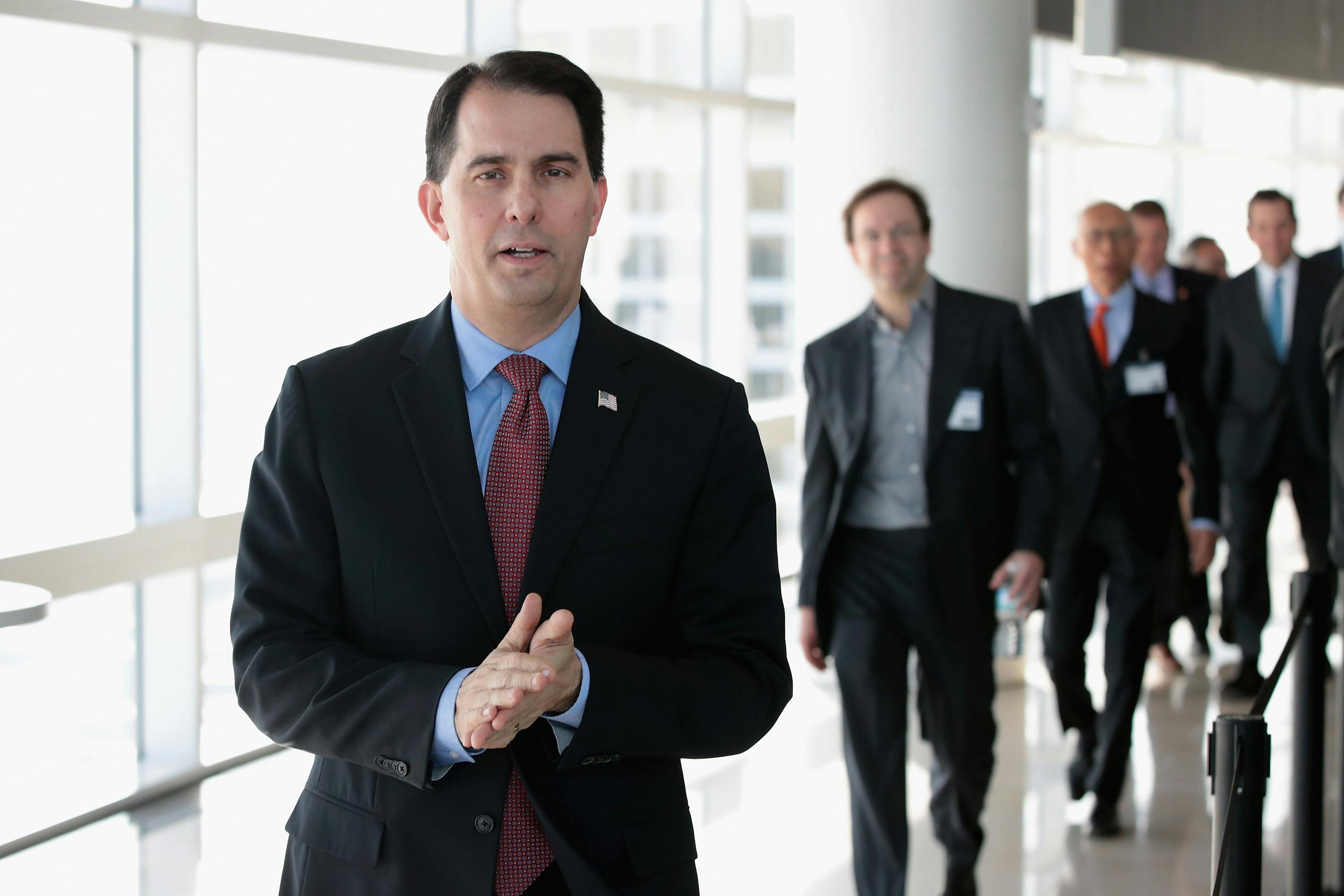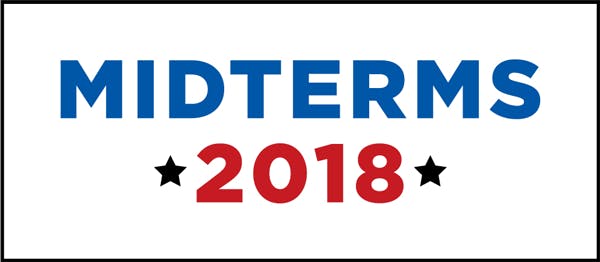

Scott Walker thought he had cracked the code. “You divide and conquer,” he famously told a major right-wing donor, days before beginning his first term as Wisconsin’s governor. If he could break the public employee unions, who funded Democratic candidates in his state, Republicans would never lose an election again. He’d be free to reward friends and punish enemies until he got sick of winning.
For a while, Walker was right. He won three elections in four years, including a bruising recall. Wisconsin was the ideological laboratory of conservative dreams. But then Walker got greedy. Not content to simply do the bidding of corporate interests through low tax rates and deregulation, he embarked on one of the biggest economic disasters in recent history. After Tuesday’s elections, we can say it was one of the biggest political ones as well.
In July 2017, Walker inked a deal with Foxconn, the Chinese manufacturer known for being so punishing to its workers that it had to install nets to prevent suicides. Foxconn would build a state-of-the-art manufacturing plant in Mount Pleasant, Wisconsin, producing LCD screens for large-panel televisions—a first for North America. The company claimed this would create 13,000 good-paying jobs and $10 billion in investment. In exchange, Walker offered $3 billion in state subsidies.
“The Foxconn campus will be large enough to hold 11 Lambeau Fields,” Walker gushed when announcing the agreement. His approval ratings had sagged after a lackluster presidential run, and he had failed to keep his first-term promise of creating 250,000 new jobs. The Foxconn deal would be the capstone of his tenure, a public-private partnership to create a high-tech hub in the upper Midwest—a real legacy item.
Instead, the deal was just a way to flush out taxpayer money, without getting much from Foxconn in return. Walker was nothing but a bagman for a coordinated hit on Wisconsin’s treasury, and he paid for it. On Tuesday, he ran into a little-understood fact of modern political life: corporate welfare is deeply unpopular.
The $3 billion subsidy to Foxconn quickly grew to over $4.5 billion, including local government tax abatements, new roads to connect to the plant, and a ratepayer-funded power transmission line. “Since Wisconsin already exempts manufacturing companies from paying taxes,” Dan Kaufman wrote at The New Yorker, “Foxconn, which generated a hundred and fifty-eight billion dollars in revenue last year, will receive much of this subsidy in direct cash payments from taxpayers.” About $1 billion in subsidies will be paid regardless of whether Foxconn builds anything at all.
At the same time, Foxconn, famous for backing out of promises made around the world, radically changed the type of plant they would construct, from big-screen TV panels to panels about half the size. That would reduce investment to about one-quarter of the $10 billion initially planned, and cut assembly-line workers to only 10 percent of the total personnel, according to an interview with Foxconn spokesperson Louis Woo in August. Most assembly work would be done by robots. Those forgotten men and women, the laid-off Midwestern factory workers looking for a new career, Foxconn isn’t hiring.
The plant would now be staffed, Foxconn said, with “knowledge” workers devising new uses for the glass panels. And just this week, The Wall Street Journal let slip that Foxconn “is considering bringing in personnel from China” to staff those knowledge jobs, citing difficulties in finding skilled labor. In the same article, Foxconn said they would “ultimately” hire 13,000 employees. But The New Yorker’s Kaufman pegged the new cost per job as high as $1 million.
That’s not all. Special grants from the Environmental Protection Agency exempted pollution limits at the plant, which will utilize several hazardous chemicals. The state cleared the way to dump waste runoff into wetlands. The Wisconsin legislature essentially turned over the court system to Foxconn, giving it a special appeals process direct to the conservative-leaning state supreme court. Eminent domain was used aggressively to push residents off the proposed site.
So everyone in Wisconsin had a reason to seethe about Foxconn: environmentalists, homeowners, workers, taxpayers, you name it. The deal never had high approval ratings, and it became a lead weight around Walker’s re-election. On Tuesday, state school superintendent Tony Evers bested Walker by about 31,000 votes. Walker’s failure has many causes, including the mobilization of working-class voters in Milwaukee by groups like Fight for $15. But given such a narrow victory, Evers’s prominent blasting of the Foxconn deal, and the environmental giveaways that helped secure it, were likely part of the margin.
Walker came into the race with plenty of advantages, including the best economy of his tenure, with unemployment numbers at just 3.0 percent. But a politician cannot push $4.5 billion into the waiting arms of a prosperous company and not expect blowback, especially when the company doesn’t follow through on its promises.
That’s an important lesson for other governors and mayors who promote corporate welfare under the guise of “economic development.” That includes Andrew Cuomo in New York and Ralph Northam in Virginia, the Democratic governors of the two states rumored to have landed HQ2, Amazon’s second corporate headquarters, in exchange for billions in subsidies. It even includes Evers, who has been noncommittal about what he’ll do about the Foxconn catastrophe, expressing reluctance to stop the bulldozers now that ground has been broken.
The truth is that these budget-breaking deals don’t create many jobs or improve local economies, according to the most exhaustive studies out there. They provide nice backdrops for press events, where everyone can hold a shovel and look the part of a successful politician. But they pale next to the kinds of activities that actually create sustainable economies, like building top-flight education, health care, and transportation systems. Corporate subsidies rob states of actually developing such systems and lower the overall quality of life. And sometimes, in Walker’s case, they even cost jobs.

In 2016, two members of Congress—one Republican and one Democrat—decided they wanted to end partisan gridlock over global warming. So, in partnership with the advocacy group Citizens’ Climate Lobby, they founded the bipartisan Climate Solutions Caucus. To join, members of Congress would have to publicly declare their concern about human-caused climate change. But there was a catch: No Democrat could join unless they had a Republican colleague to bring along.
The Climate Solutions Caucus had less than a dozen members when it was founded. But by 2018, it had 45 Democrats and 45 Republicans, seemingly united on the desire to solve, or at least slow, global warming.
The Climate Solution Caucus was gutted in Tuesday’s elections. Voters threw out 13 Republican members, including the club’s co-founder and co-chair, South Florida Republican Carlos Curbelo. Combined with retiring members, those losses mean the number of GOP members “will decrease to 24, a 47 percent decline,” according to ThinkProgress. That implies the overall membership will be slashed by about half, since Democrats can’t be members without Republican counterparts.
Here's what I think happens next in American climate action:
Sadly, the era of bipartisan climate action in the U.S. is probably over. The Climate Solutions Caucus, filled with moderate Republicans, has all but crumbled tonight. WA I-1631, a market-based climate policy, failed.
The club’s decimation might feel like a loss to some climate advocates. But for others, it was welcome news. On Wednesday morning, the progressive super PAC Climate Hawks Vote released a statement claiming it had “succeeded in its goal” to “end the farce that is the Climate ‘Solutions’ Caucus.” The group had been running television ads against Curbelo in Florida, pointing out that he had “taken tens of thousands of dollars from fossil fuel interests” and voted for a number of anti-climate policies.
“We targeted Curbelo specifically because he was perceived as a Republican voice of reason on climate even as he criticized ‘alarmists’ on hurricanes wreaking havoc on his state,” RL Miller, the president of the group, said in a statement. Curbelo was indeed seen as a voice of reason on the issue; in July, he proposed a carbon tax bill that the National Resources Defense Council called “one of the first substantive proposals in many years by a congressional Republican” to address global warming.
But the caucus wasn’t full of Republicans like Curbelo. It included many members whose voting records showed zero support for climate solutions. Republican member Matt Gaetz, for example, once proposed a bill to abolish the Environmental Protection Agency. Thus, to Miller and many other environmentalists, the Climate Solutions Caucus has served more as a cover for Republicans to pretend they care about solving global warming, rather than a body that actually works to pass meaningful legislation.
Steve Valk, the communications director for Citizens’ Climate Lobby, understands the criticism. “I think it’s legitimate,” he told me on Wednesday. But Valk says the group exists in order to address a harsh reality—that action on climate change will never happen without Republican engagement. Joining the caucus is just the first step of that process, he said. “Obviously we want them to go beyond just joining the caucus. But to get them to do that, that’s really up to us, the constituents, to give them the support to grab the next piece of the ladder and climb up.”
So, despite the loss of many of its members, Valk said Congress’s bipartisan climate club is going to continue—and that more Republicans will join in the next Congress. “I think there will be enough to replace what they lost in the election,” he said. But who will be the Republican leader now that Curbelo is gone? “Everybody wants to know that for some reason,” he said. “We’re not going to speculate on it right now.”
These are issues the group will face when it sends upwards of 600 volunteers to Washington, D.C., next week to talk with members of Congress about joining. “We’re looking to make climate change a bridge issue instead of a wedge issue; to make it safe for Republicans to step up and take some action,” Valk said. “We’re hoping next week we can set the table for some bipartisan legislation.”
But finding Republicans to join the club, let alone lead it, will be considerably harder than it was in 2016 because the midterms wiped out House Republicans who didn’t wholeheartedly embrace Trump. “We are waking up to a Republican Party that is decidedly more Trumpian than the one it was yesterday,” Ben Domenech, publisher of The Federalist, said on CBS. “This is a situation where Republican moderates are getting creamed.” With the country more politically divided than ever, the Democrats may decide to go at it alone in the fight against global warming. After all, what’s the point of a bipartisan climate caucus if only half of its members are offering solutions?

The last two years in American politics have spelled trouble for the global climate, thanks largely to the Trump administration. And the next two years probably won’t be much better, given the results of Tuesday’s midterm elections.
Voters failed to pass a historic ballot initiative in Washington state to create the first-ever carbon tax in the United States. They rejected a ballot measure to increase renewable energy in Arizona, and to limit fracking in Colorado. Some of Congress’ most outspoken climate deniers held onto their seats. Several candidates who ran on explicitly pro-climate agendas lost.
Democrats did not quite get the blue wave they wanted, but it was even worse for environmentalists. There was no green wave whatsoever. That’s partially because of record political spending by the fossil fuel industry to oppose pro-climate initiatives, but also because of the Democratic Party’s failure as a whole to draw much attention to the issue.
The midterm elections were always going to be consequential for climate change. The world’s governments only have about twelve years to implement policies that can limit global warming to 1.5 degrees Celsius. That’s the point at which catastrophic impacts begin, according to a recent report from an international consortium of scientists.
The U.S., as the largest historical emitter of greenhouse gases, is essential to achieving that target. But for the last two years, the U.S. government has been ignoring the need to reduce emissions—and in many cases, actively working against it. Along with withdrawing from the Paris climate agreement, President Donald Trump has been attempting to repeal and weaken existing climate regulation, with the support of the Republican-controlled Congress.
The midterms gave voters two opportunities to change America’s course on climate change. They could have elected a Congress that would no longer support Trump’s anti-climate agenda. And they could have approved strong statewide climate policies to counter the federal government’s inaction.
Voters took the first opportunity, but only slightly. Democrats won the House of Representatives, making it near-impossible for Trump to pass any anti-climate legislation.
But voters didn’t elect many candidates who ran on pro-climate agendas. Environmentalists had hoped that Florida, being on the front lines of climate change, would make history in that regard. But Democratic Senator Bill Nelson, a climate champion, was unseated by Governor Rick Scott, a Republican accused of banning the word climate from state government websites. And Democratic gubernatorial candidate Andrew Gillum, who pledged to act swiftly on climate, lost to a Republican who has dismissed the problem.
Voters rejected almost every opportunity to enact strong state-level climate policies. The biggest failure by far was in Washington. Initiative 1631 would have made the state the first in the country to charge polluters for their emissions. The proceeds from the carbon fee could have provided Washington with “as much as $1 billion annually by 2023 to fund government programs related to climate change,” Fortune reported, and “potentially kickstart a national movement to staunch greenhouse gases.” The measure lost by 12 percentage points.
The renewable energy ballot initiative in Arizona also presented a big opportunity to reduce emissions. Proposition 127 would have required electric companies in Arizona to get half of their power from renewable sources like solar and wind by 2030. (In a rare win for the environment on Tuesday, Nevada voters passed their own version of that initiative.) Proposition 112, Colorado’s ballot initiative to keep oil and gas drilling operations away from where people live, was far more about protecting public health than it was about limiting climate change. But the effect would have been to limit further fossil fuel extraction in the state.
The oil and gas industry spent quite a lot of money opposing all of these pro-climate ballot initiatives. The campaign against Washington’s carbon fee “raised $20 million, 99 percent of which has come from oil and gas,” according to Vox. The carbon fee was thus one of the most expensive ballot initiative fights in Washington state history. The renewable energy fight in Arizona was also the most expensive in state history because of oil industry spending. The same was true for Colorado’s anti-fracking measure, as the oil and gas industry clearly spent nearly $40 million opposing it.
While Tuesday’s results show the impact of massive political spending by the fossil fuel lobby, they also shine a light on Democrats’ failure to mobilize voters on the issue. The Democratic Party has failed to treat climate change with much, if any urgency this election season. According to The New York Times, the “vast majority” of the party’s candidates did not mention the problem “in digital or TV ads, in their campaign literature or on social media.” And the party’s leaders in Congress have given little indication that they intend to prioritize climate change in the future. Is it any wonder voters weren’t excited about solving the problem, either?
Correction: A previous version of this story stated that Nevada voters rejected Question 6, a ballot initiative on renewable energy. The measure won.

Only two hours after election results started trickling in, CNN correspondent Jake Tapper brought the gavel down. “This is not a blue wave,” he declared. “This is not a wave knocking out all sorts of Republican incumbents.”
Tapper said this shortly after a winner was projected in Kentucky’s 6th Congressional District. Democrats had hoped that former fighter pilot Amy McGrath would take down incumbent Andy Barr, who voted to repeal Obamacare last year. In 2016, Barr won the district by more than 22 points. On Tuesday, he held onto his seat by just three points.
But yes, it was a disappointing result, one of several in the night. Democrats expected to win the governor’s office in Florida, where black progressive rising star Andrew Gillum was leading in the polls—and whose popularity was expected to buoy struggling Senate incumbent Bill Nelson. Both Gillum and Nelson lost. Democrats had hoped to win the governor’s race in Georgia, where Stacey Abrams was running a surprisingly competitive race to become the country’s first black woman governor. But as in Florida, a racist campaign by her Republican opponent took its toll. Republicans are poised to win there as well.
Watching this unfold early in the evening, CNN commentator Van Jones could only shake his head. “This is heartbreaking. It’s heartbreaking,” he said. “The hope has been that the antibodies would kick in. That this infestation of hatred and division would draw a response from the American people in both parties to say ‘No, no more.’”
It’s true that, when judged against the Democrats’ best-case scenario—winning big in Florida, scoring an upset in Georgia, and holding the line in the Senate—Tuesday was disappointing. Republicans, surely, are relieved. They lost the House of Representatives, but they made gains in the Senate and held onto governor’s mansions in Florida and Ohio, two key 2020 swing states. The midterms were not a magic bullet, an event that sent an unequivocal rebuke to President Donald Trump. But they were by definition a blue wave, a massive popular vote against the president.
The NYT currently projects a national popular-vote margin of D+9.2%. The largest popular margin since 2008, larger than waves of 1994, 2006, 2010, 2014.
1994: R+7.1%
2006: D+8.0%
2008: D+10.6%
2010: R+7.2%
2014: R+5.7%
By historical standards, this a popular wave. pic.twitter.com/4hw71hieVN
Most polling suggested that Democrats would win around 30 seats in the House, giving them a majority of around 15 seats. Most polling, similarly, saw them losing ground in the Senate, where they faced one of the toughest reelection maps in recent history. Democratic senators underperformed, with Indiana incumbent Joe Donnelly and Tennessee challenger Phil Bredesen losing badly. But in the House, although they didn’t pick up longshot districts like McGrath’s, they at least met expectations. When the dust has settled, they may very well have exceeded those expectations.
Given how few opportunities there have been over the past two years to send strong messages to the White House, it’s understandable how Tuesday’s results could look like a disappointment. Trump and Republicans will certainly declare a kind of victory, particularly in the Senate.
Tremendous success tonight. Thank you to all!
— Donald J. Trump (@realDonaldTrump) November 7, 2018For Trump, who stumped for many of Tuesday’s GOP Senate winners, this may seem like a particularly important moment, one that proves that he is an unparalleled campaigner. For Democrats, there was hope in candidates like Florida’s Andrew Gillum, Georgia’s Stacey Abrams, and Texas’ Beto O’Rourke—partly because they are young, rising stars in the party, but also because their unexpected popularity represented the kind of progressive tsunami that many Democrats hoped for. If the party could turn Georgia and Texas blue, after all, then Trump was all but done for.
But as the midterms have shown, eradicating the disease of Trumpism will take more than just an energized Democratic base. Trump’s brand of ethno-nationalist conservatism has taken over the GOP, over the last six months in particular. Republican gubernatorial candidates in Florida and Georgia ran two of the most explicitly racist campaigns in recent memory, and won, likely validating the strategy in their minds. Expect future Republican candidates to lean even further into voter suppression and white grievance.
But even if Democrats didn’t win some of the biggest (and unlikeliest) races, they ended up where many predicted: a little worse off in the Senate, and much better off in the House and the states, where they have been eviscerated in recent years. The party made important inroads in the Midwest and South; Kris Kobach lost his gubernatorial campaign in Kansas, while Texas and Georgia are seemingly in play for 2020. And although Gillum and O’Rourke lost, their competitive races likely boosted statewide turnout and contributed to the unseating of key House Republicans like Carlos Cabelo, in Florida, and Pete Sessions, in Texas.
The media might focus on the Democrats’ high-profile losses, even though most were either underdogs (like O’Rourke) or incumbents in states that Trump won two years ago. But the real indicator is the Democrats’ popular vote total, which is projected to significantly outpace the Republicans’. Given that this was a midterm election, and that the Senate map was extremely unfavorable to Democrats (who had to defend 26 of the 35 seats up for election), those numbers will likely increase in 2020. With more of the country up for grabs, Republicans may be forced to expend resources in unexpected places. Abrams and O’Rourke, in particular, showed Democrats how to run in those places.
The midterms were a reminder that the fight against Trump will not be easy, especially given the many structural advantages for Republicans, including the Electoral College, voter suppression, and gerrymandering. But Tuesday’s results were also a reminder that the fundamentals are on Democrats’ side. A majority of American voters (still) favors the Democrats over Trump and his party, and have now granted them the power to lead investigations into the administration and block Republican legislation. As Van Jones said later in the evening, after CNN called the House for Democrats, “My heart has been restored. It is the end of one-party rule in the United States, thank god, and the beginning of a new Democratic Party.”


No comments :
Post a Comment